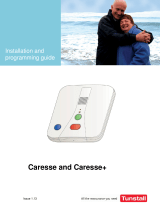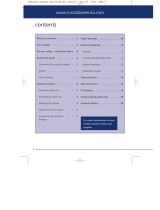Page is loading ...

Doc No. FM0791 issue B Page 1
We declare this product complies with the relevant UK
legislation on condition that it is used in the manner
intended, and in accordance with the current installation
standards and/or the manufacturer's recommendations.
A copy of the full UKCA Declaration of Conformity is
available on request.
169MHz Telecare Devices
Bogus Caller Button (Code 18)
___________________________________________________________________________________________________________
• Compatible with Reach at-home alarms from December 2016 onwards
• Red call reassurance light
• Screw and suction cup fixing options supplied
• Low battery warning
• Dimensions: 50mm x 33mm x 22mm (HxWxD) inc. bracket
• Weight: 20 grams
• Product Code: ZXT489
Compatibility
The bogus caller switch can only be used with Reach at-home alarm units manufactured since December 2016 onwards.
These units will be marked on the rear battery cover label with the following build levels or greater; Reach: D2, Reach Plus: D2,
Reach Plus GSM: C3 and Reach Ultra: B3.
What is the Bogus Caller Button used for?
The bogus caller button will initiate a “silent dial” alarm call on a Reach at-home alarm unit with speech in the listen mode only.
The button can be pressed by the resident if they feel threatened or uneasy with a visitor - the control centre can listen-in to
assess the situation before taking appropriate action.
Where should the Bogus Caller Button be fitted?
The bogus caller button should be fixed on the door frame alongside the front door where it will be seen as a deterrent to visitors
that an alarm system is installed.
Typical Tools Required
Make sure the correct size Pozi screwdriver is used for the screw provided.
If the suction cup is being used on a UPVC door frame then no tools are required.
Installation
The bogus caller button is fixed with a single screw or the suction
cup through the fixing hole “A” in the rear bracket.
Screw Fixing Option – tighten the screw into the door frame until
the head is about 2mm from being fully flush.
Push the bogus caller button over the screw head and pull downwards
to lock the screw head into the slot. If the button is not a tight fit
remove and tighten the screw half a turn then retry.
Suction Cup Fixing Option – push the suction cup into hole “A” on the bogus caller button bracket and pull upwards into the slot.
Ensure the UPVC door frame surface is clean and dry, press the suction cup firmly and check it is stuck securely.
Making an Alarm Call
Simply press the SILVER button ONCE
The button will FLASH RED for about 8 seconds
Take no further action
Your call will be dealt with soon.
Registering a Bogus Caller Button
See the following page for how to register a bogus caller button onto a Reach at-home alarm unit.
The range of all radio devices can be affected by the working environment - always take care during installation and
perform several test calls from all extremes of the building.
Battery Life
The bogus caller button battery is checked once a day, if the voltage falls and stays below a preset level for 7 consecutive days a
low battery alert is automatically transmitted. Once a low battery call is received the bogus caller button should be replaced
within 7 days. Bogus caller buttons must be returned to Tynetec/Aidcall for battery replacement.
Detailed information on battery management for all Tynetec/Aidcall products is available - request Doc No. FM0630.
Declaration of Conformity
SUCTION
CUP
FIXING
SCREW
“A”
Tynetec and Aidcall are business units of Legrand Electric Ltd
Unit 10 Cowley Road, Blyth Riverside Business Park, Blyth
Northumberland, NE24 5TF. Tel: 01670 352 371
Email: sales@tynetec.co.uk Web: www.tynetec.co.uk
We declare this product complies with the relevant
European legislation on condition that it is used in the
manner intended, and in accordance with the current
installation standards and/or the manufacturer's
recommendations. A copy of the full CE Declaration of
Conformity is available on request.

Doc No. FM0791 issue B Page 2
Registering a Bogus Caller Button onto a Reach at-home alarm unit
1. Put the Reach unit into radio device learn mode…
2. Activate the bogus caller button…
3. Exit radio device learn mode…
4. Check with the Control Centre that it is convenient to perform a test call, press the bogus caller button and confirm they receive
a bogus caller alarm call. Note: speech at the Control Centre will be in listen mode only.
Deleting a Bogus Caller Button from a Reach at-home alarm unit
Enter 1 6 7 0 using the keypad on the rear of the Reach unit – the front light will FLASH FAST GREEN and the unit will announce
“Program Mode - Ready”.
Enter # 0 4 1 and the Reach will announce “Delete Radio Device” followed by a “Beep”.
Enter the 8 digit bogus caller button ID to be deleted; after the “Beep” press # to exit.
Press the key to exit Program Mode; the unit will sound a “Double-Beep” and the front light will return to STEADY GREEN.
The 8 digit ID can be found on the label on the back of the bogus caller button – it will always start with 18xxxxxx
The instructions given above for the standard Reach product also applies to the Reach Plus, Reach Plus GSM
and Reach Ultra models. Refer to the instruction booklets provided with these products for more information
on programming and testing radio devices.
Tynetec and Aidcall operate a policy of continuous improvement and reserve the right to change product specifications without notice.
If any variation to the details contained in this document are suspected please contact Tynetec’s customer support dept on 01670 352371.
Press the SILVER button once, the light will flash RED for several seconds and
the Reach will announce “Bogus Caller”.
“Trigger
Radio
Device”
Press and HOLD the GREEN button on the Reach unit.
When the front light FLASHES FAST GREEN release the
button and the Reach will announce “Trigger Radio Device”.
You now have 1 minute to activate the bogus caller button.
Press the GREEN button on the Reach unit.
The front light will return to STEADY GREEN and the Reach
is back in normal operating mode.
⚫
/




